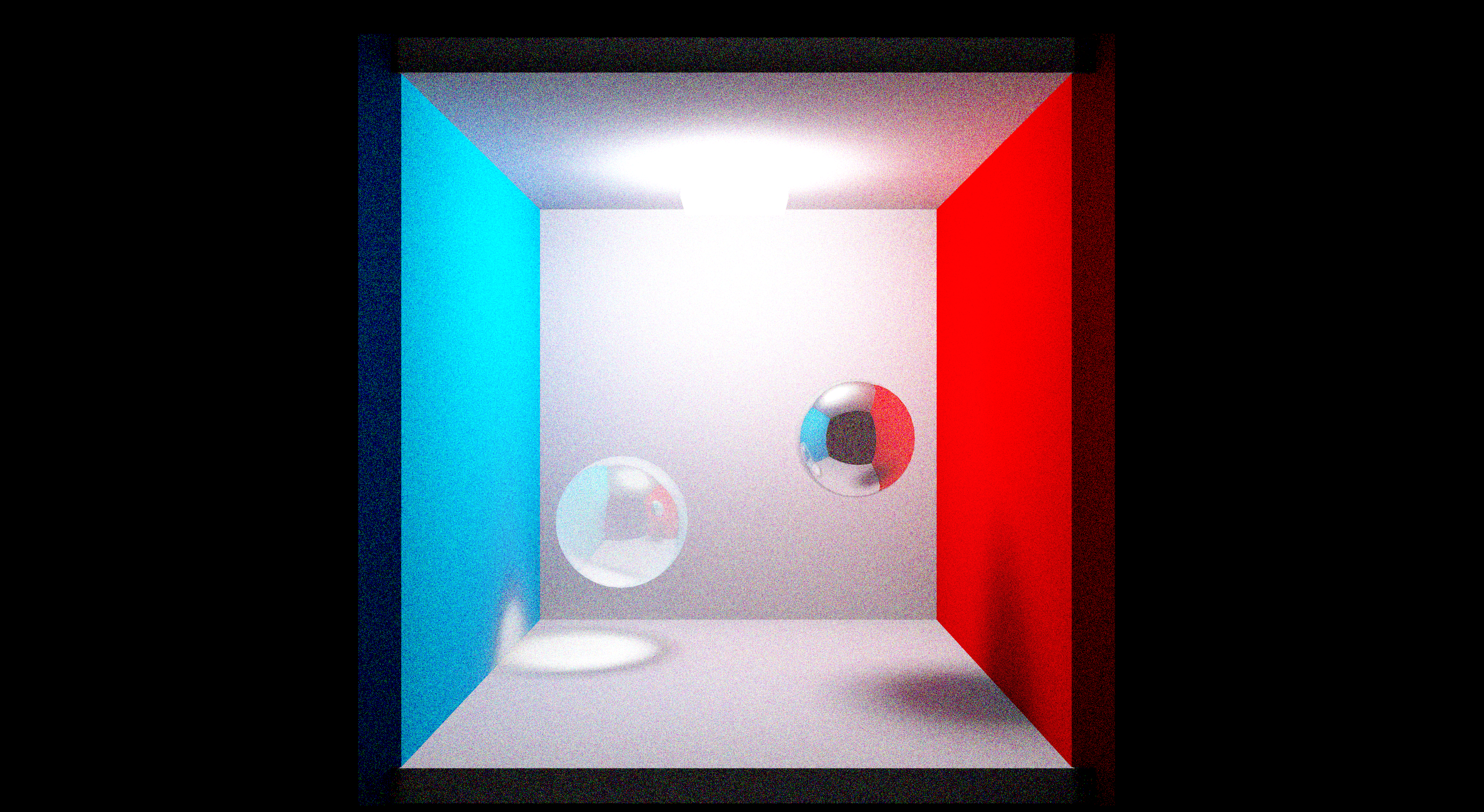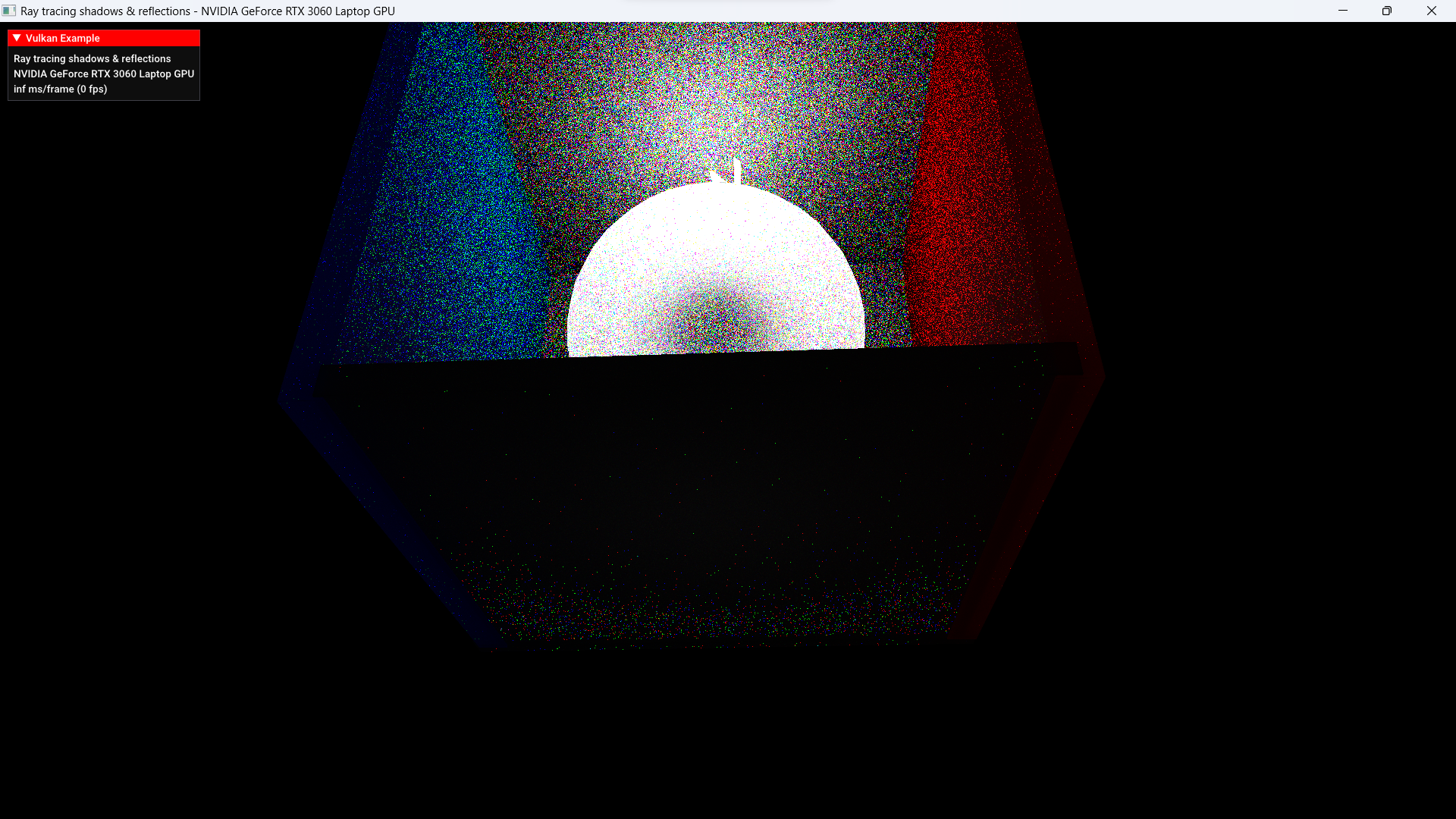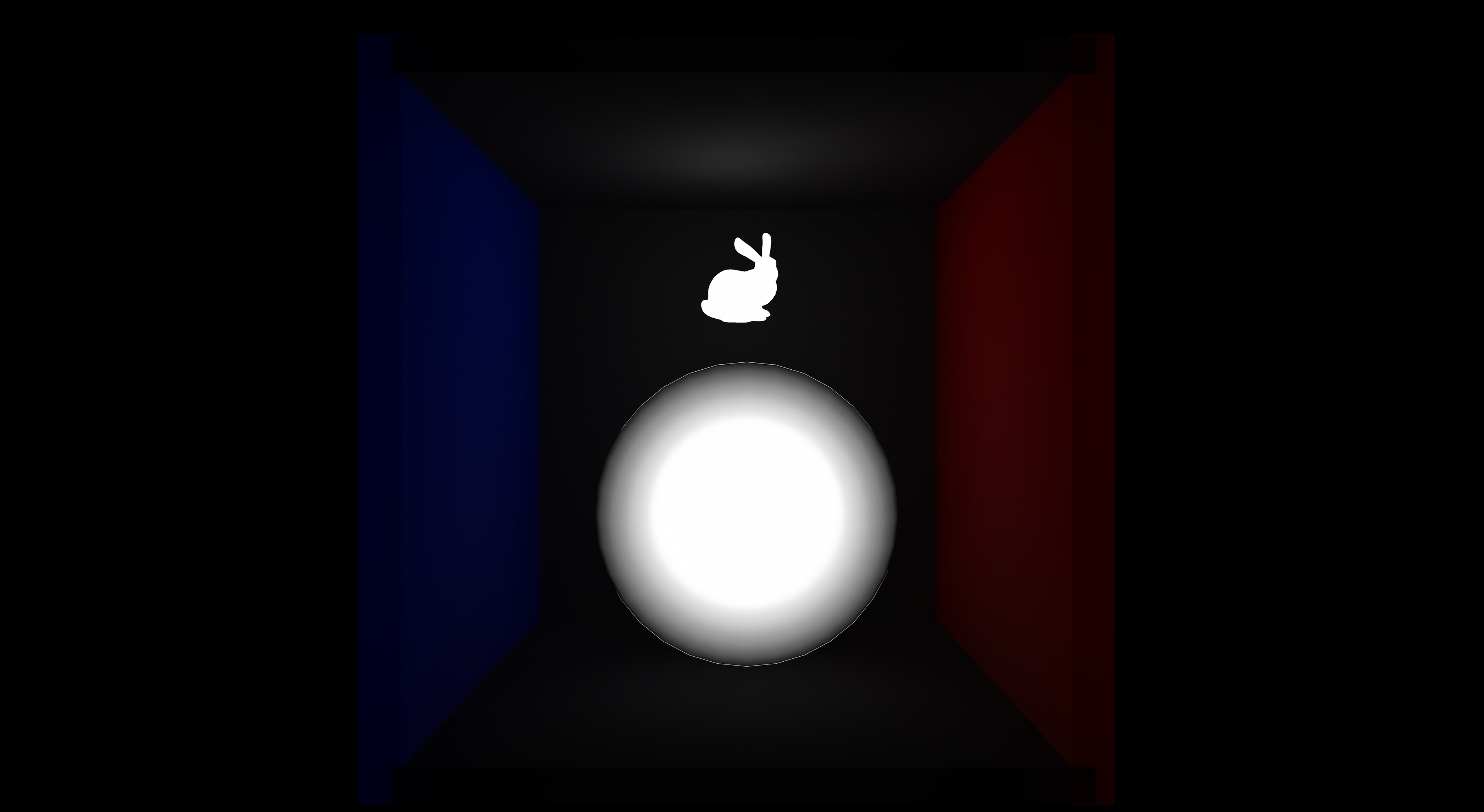Yeah, it's not working entirely the way I want it to, but I think that I'm on the right track.
#version 460
#extension GL_EXT_ray_tracing : require
#extension GL_EXT_nonuniform_qualifier : enable
layout(location = 2) rayPayloadEXT bool shadowed;
struct ray
{
vec4 direction;
vec4 origin;
bool in_use;
vec3 normal;
float depth;
int child_refract_id;
int child_reflect_id;
int child_subsurface_id;
int parent_id;
float base_color;
float accumulated_color;
float base_opacity;
float reflection_constant;
float refraction_constant;
float sss_constant;
float sss_density;
float tint_constant;
vec3 tint_colour;
bool external_reflection_ray;
bool external_refraction_ray;
bool internal_subsurface_ray;
int level;
};
// https://gist.github.com/patriciogonzalezvivo/670c22f3966e662d2f83
float mod289(float x){return x - floor(x * (1.0 / 289.0)) * 289.0;}
vec4 mod289(vec4 x){return x - floor(x * (1.0 / 289.0)) * 289.0;}
vec4 perm(vec4 x){return mod289(((x * 34.0) + 1.0) * x);}
float noise3(vec3 p, float wavelength){
p /= wavelength;
vec3 a = floor(p);
vec3 d = p - a;
d = d * d * (3.0 - 2.0 * d);
vec4 b = a.xxyy + vec4(0.0, 1.0, 0.0, 1.0);
vec4 k1 = perm(b.xyxy);
vec4 k2 = perm(k1.xyxy + b.zzww);
vec4 c = k2 + a.zzzz;
vec4 k3 = perm(c);
vec4 k4 = perm(c + 1.0);
vec4 o1 = fract(k3 * (1.0 / 41.0));
vec4 o2 = fract(k4 * (1.0 / 41.0));
vec4 o3 = o2 * d.z + o1 * (1.0 - d.z);
vec2 o4 = o3.yw * d.x + o3.xz * (1.0 - d.x);
return o4.y * d.y + o4.x * (1.0 - d.y);
}
const float TWO_PI = 8.0 * atan(1.0);
vec3 aabb_min = vec3(-2.5, -2.5, -2.5);
vec3 aabb_max = vec3(2.5, 2.5, 2.5);
const float opacity_factor = 0.01;
vec3 fog_colour = vec3(1.0, 1.0, 1.0);
uint prng_state = 0;
layout(binding = 0, set = 0) uniform accelerationStructureEXT topLevelAS;
layout(binding = 1, set = 0, rgba8) uniform image2D color_image;
layout(binding = 2, set = 0) uniform UBO
{
mat4 viewInverse;
mat4 projInverse;
mat4 transformation_matrix;
vec3 camera_pos;
int vertexSize;
bool screenshot_mode;
uint tri_count;
uint light_tri_count;
} ubo;
layout(binding = 3, set = 0) buffer Vertices { vec4 v[]; } vertices;
layout(binding = 4, set = 0) buffer Indices { uint i[]; } indices;
struct RayPayload
{
vec3 color;
float dist;
vec3 normal;
float reflector;
float opacity;
float tint;
vec3 tint_colour;
float subsurface;
float density;
};
layout(location = 0) rayPayloadEXT RayPayload rayPayload;
// Max. number of recursion is passed via a specialization constant
layout (constant_id = 0) const int MAX_RECURSION = 0;
const int buffer_size = 16;
vec3 rgb2hsv(vec3 c)
{
vec4 K = vec4(0.0, -1.0 / 3.0, 2.0 / 3.0, -1.0);
vec4 p = mix(vec4(c.bg, K.wz), vec4(c.gb, K.xy), step(c.b, c.g));
vec4 q = mix(vec4(p.xyw, c.r), vec4(c.r, p.yzx), step(p.x, c.r));
float d = q.x - min(q.w, q.y);
float e = 1.0e-10;
return vec3(abs(q.z + (q.w - q.y) / (6.0 * d + e)), d / (q.x + e), q.x);
}
vec3 hsv2rgb(vec3 c)
{
vec4 K = vec4(1.0, 2.0 / 3.0, 1.0 / 3.0, 3.0);
vec3 p = abs(fract(c.xxx + K.xyz) * 6.0 - K.www);
return c.z * mix(K.xxx, clamp(p - K.xxx, 0.0, 1.0), c.y);
}
float stepAndOutputRNGFloat(inout uint rngState)
{
// Condensed version of pcg_output_rxs_m_xs_32_32, with simple conversion to floating-point [0,1].
rngState = rngState * 747796405 + 1;
uint word = ((rngState >> ((rngState >> 28) + 4)) ^ rngState) * 277803737;
word = (word >> 22) ^ word;
return float(word) / 4294967295.0f;
}
// https://github.com/nvpro-samples/vk_mini_path_tracer/blob/main/vk_mini_path_tracer/shaders/raytrace.comp.glsl#L26
// https://www.shadertoy.com/view/fsK3zd
//
vec3 RandomUnitVector(inout uint state)
{
float z = stepAndOutputRNGFloat(state) * 2.0f - 1.0f;
float a = stepAndOutputRNGFloat(state) * TWO_PI;
float r = sqrt(1.0f - z * z);
float x = r * cos(a);
float y = r * sin(a);
return normalize(vec3(x, y, z));
}
// I forget where this came from
vec3 cosWeightedRandomHemisphereDirection( const vec3 n, inout uint state )
{
vec2 r = vec2(stepAndOutputRNGFloat(state), stepAndOutputRNGFloat(state));
vec3 uu = normalize( cross( n, vec3(0.0,1.0,1.0) ) );
vec3 vv = cross( uu, n );
float ra = sqrt(r.y);
float rx = ra*cos(6.2831*r.x);
float ry = ra*sin(6.2831*r.x);
float rz = sqrt( 1.0-r.y );
vec3 rr = vec3( rx*uu + ry*vv + rz*n );
return normalize( rr );
}
bool in_aabb(vec3 pos, vec3 aabb_min, vec3 aabb_max)
{
if((pos.x >= aabb_min.x && pos.x <= aabb_max.x) &&
(pos.y >= aabb_min.y && pos.y <= aabb_max.y) &&
(pos.z >= aabb_min.z && pos.z <= aabb_max.z))
return true;
else
return false;
}
bool BBoxIntersect(const vec3 boxMin, const vec3 boxMax, const vec3 origin, const vec3 dir, out float out_t0, out float out_t1)
{
vec3 invdir = 1.0 / dir;
vec3 tbot = invdir * (boxMin - origin);
vec3 ttop = invdir * (boxMax - origin);
vec3 tmin = min(ttop, tbot);
vec3 tmax = max(ttop, tbot);
vec2 t = max(tmin.xx, tmin.yz);
float t0 = max(t.x, t.y);
t = min(tmax.xx, tmax.yz);
float t1 = min(t.x, t.y);
out_t0 = t0;
out_t1 = t1;
return t1 > max(t0, 0.0);
}
float trace_path_backward(const int steps, const vec3 origin, const vec3 direction, const float hue, const float eta)
{
vec3 o = origin;
vec3 d = direction;
const float energy = 1;
const float caustic_energy = 1;//energy;
float ret_colour = 0;
float local_colour = energy;
float total = 0;
bool doing_refraction_caustic = false;
const vec3 mask = hsv2rgb(vec3(hue, 1.0, 1.0));
for(int i = 0; i < steps; i++)
{
const float tmin = 0.001;
const float tmax = 10000.0;
traceRayEXT(topLevelAS, gl_RayFlagsOpaqueEXT, 0xff, 0, 0, 0, o, tmin, d, tmax, 0);
total += mask.r;
total += mask.g;
total += mask.b;
if(doing_refraction_caustic)
{
local_colour += caustic_energy*(rayPayload.color.r*mask.r + rayPayload.color.g*mask.g + rayPayload.color.b*mask.b);
doing_refraction_caustic = false;
}
else
{
local_colour *= (rayPayload.color.r*mask.r + rayPayload.color.g*mask.g + rayPayload.color.b*mask.b);
}
// If hit the sky
if(rayPayload.dist == -1.0)
{
ret_colour += local_colour;
break;
}
// If this is simply the final step
// then don't throw away perfectly
// good data
if(i == steps - 1)
{
ret_colour += local_colour;
break;
}
vec3 hitPos = o + d * rayPayload.dist;
if(stepAndOutputRNGFloat(prng_state) <= rayPayload.opacity)
{
vec3 o_reflect = hitPos + rayPayload.normal * 0.01;
vec3 d_reflect = reflect(d, rayPayload.normal);
vec3 o_scatter, d_scatter;
if(stepAndOutputRNGFloat(prng_state) <= rayPayload.subsurface)
{
o_scatter = hitPos - rayPayload.normal * 0.001 + RandomUnitVector(prng_state)*0.001;// hitPos.xyz - rayPayload.normal * 0.001 + RandomUnitVector(prng_state)*0.001;//hitPos + rayPayload.normal * 0.01;
d_scatter = RandomUnitVector(prng_state);
}
else
{
o_scatter = hitPos + rayPayload.normal * 0.01;
d_scatter = cosWeightedRandomHemisphereDirection(rayPayload.normal, prng_state);
}
o = mix(o_scatter, o_reflect, rayPayload.reflector);
d = normalize(mix(d_scatter, d_reflect, rayPayload.reflector));
}
else
{
doing_refraction_caustic = true;
vec3 o_transparent = vec3(0.0);
vec3 d_transparent = vec3(0.0);
// Incoming
if(dot(d, rayPayload.normal) <= 0.0)
{
o_transparent = hitPos.xyz - rayPayload.normal * 0.01f;
d_transparent = refract(d, rayPayload.normal, eta);
}
else // Outgoing
{
vec3 temp_dir = refract(d, -rayPayload.normal, 1.0 / eta);
if(temp_dir != vec3(0.0))
{
o_transparent = hitPos.xyz + rayPayload.normal * 0.01f;
d_transparent = mix(temp_dir, RandomUnitVector(prng_state), rayPayload.subsurface);// temp_dir;
}
else
{
// Total internal reflection
o_transparent = hitPos.xyz - rayPayload.normal * 0.01f;
d_transparent = mix(reflect(d, -rayPayload.normal), RandomUnitVector(prng_state), rayPayload.subsurface);//reflect(d, -rayPayload.normal);
}
}
o = o_transparent;
d = normalize(d_transparent);
}
}
return ret_colour / total;
}
float get_radiance_backward(const int samples, const int steps, const vec3 origin, const vec3 seed_direction, const float hue, const float eta)
{
RayPayload r = rayPayload;
float ret_colour = 0.0;
for(int s = 0; s < samples; s++)
ret_colour += trace_path_backward(steps, origin, seed_direction, hue, eta);
rayPayload = r;
return ret_colour / samples;
}
float get_omni_radiance_backward(const int samples, const int steps, const vec3 origin, const float hue, const float eta)
{
RayPayload r = rayPayload;
float ret_colour = 0.0;
for(int s = 0; s < samples; s++)
ret_colour += trace_path_backward(steps, origin, RandomUnitVector(prng_state), hue, eta);
rayPayload = r;
return ret_colour / samples;
}
void get_fog(inout float dist_color, inout float dist_opacity, vec3 origin, vec3 direction, vec3 hitPos, float hue, float eta)
{
vec3 start = origin;
vec3 end = origin;
float t0 = 0.0;
float t1 = 0.0;
const float target_step_length = 0.1;
if(in_aabb(origin, aabb_min, aabb_max))
{
vec3 backout_pos = origin - direction.xyz*10000.0;
if(BBoxIntersect(aabb_min, aabb_max, backout_pos, direction.xyz, t0, t1))
{
start = origin;//backout_pos + direction.xyz*t0;
end = backout_pos + direction.xyz*t1;
}
}
else
{
if(BBoxIntersect(aabb_min, aabb_max,origin, direction.xyz, t0, t1))
{
start = origin + direction.xyz*t0;
end = origin + direction.xyz*t1;
}
}
if(distance(origin, start) > distance(origin, hitPos.xyz))
start = hitPos.xyz + rayPayload.normal * 0.01f;
if(distance(origin, end) > distance(origin, hitPos.xyz))
end = hitPos.xyz + rayPayload.normal * 0.01f;
const int num_steps = int(floor((distance(start, end) / target_step_length)));
if(num_steps >= 2)
{
const vec3 step = (end - start) / (num_steps - 1);
vec3 curr_step = start;
for(int j = 0; j < num_steps; j++, curr_step += step)
{
float colour = get_omni_radiance_backward(10, 5, curr_step, hue, eta);
float noise = noise3(curr_step, 1.0);
// noise *= noise3(curr_step, 1.0/2.0);
// noise *= noise3(curr_step, 1.0/4.0);
// noise *= noise3(curr_step, 1.0/8.0);
//colour *= noise;
const float trans = 1.0 - clamp(dist_opacity, 0.0, 1.0);
dist_color += colour*trans;
dist_opacity += 0.1*colour*trans;
}
}
const vec3 mask = hsv2rgb(vec3(hue, 1.0, 1.0));
dist_color *= (fog_colour.r*mask.r + fog_colour.g*mask.g + fog_colour.b*mask.b);
}
void get_origin_and_direction(inout vec4 origin, inout vec4 direction, float x, float y, float image_width, float image_height)
{
const vec2 pixelCenter = vec2(x, y) + vec2(0.5);
const vec2 inUV = pixelCenter/vec2(image_width, image_height);
vec2 d = inUV * 2.0 - 1.0;
origin = ubo.viewInverse * vec4(0,0,0,1);
vec4 target = ubo.projInverse * vec4(d.x, d.y, 1, 1);
direction = ubo.viewInverse*vec4(normalize(target.xyz / target.w), 0);
}
bool is_inside_mesh(const vec3 location)
{
RayPayload r = rayPayload;
bool is_outside = false;
const vec3 direction = vec3(0, 1, 0);
traceRayEXT(topLevelAS, gl_RayFlagsOpaqueEXT, 0xff, 0, 0, 0, location, 0.001, direction, 10000.0, 0);
if(rayPayload.dist == -1.0 || dot(direction, rayPayload.normal) <= 0.0)
is_outside = true;
rayPayload = r;
return !is_outside;
}
int do_random_walk_until_exits_mesh(const float density, const int max_walk_length, vec3 pos, inout vec3 final_pos, inout vec3 final_dir, inout float base_opacity)
{
final_pos = pos;
final_dir = RandomUnitVector(prng_state);
base_opacity = 0.0;
int i = 1;
while(is_inside_mesh(pos) && i <= max_walk_length)
{
final_dir = RandomUnitVector(prng_state);
final_pos += final_dir*(1 - density);
base_opacity += (1.0 - clamp(base_opacity, 0.0, 1.0))*density;
i++;
}
return i;
}
float get_ray0(vec4 origin, vec4 direction, const float hue, const float eta)
{
// This algorithm stops when the buffer runs out of space,
// or when the rays miss everything,
// or when the level is too deep
ray rays[buffer_size];
int current_buffer_index = 0;
uint rayFlags = gl_RayFlagsOpaqueEXT;
uint cullMask = 0xff;
float tmin = 0.001;
float tmax = 10000.0;
// Step one: make tree of ray segments
for(int i = 0; i < buffer_size; i++)
{
// Initialize buffer
rays[i].in_use = false;
rays[i].child_reflect_id = -1;
rays[i].child_refract_id = -1;
rays[i].child_subsurface_id = -1;
rays[i].parent_id = -1;
rays[i].external_reflection_ray = false;
rays[i].external_refraction_ray = false;
rays[i].internal_subsurface_ray = false;
rays[i].normal = vec3(0, 0, 0);
rays[i].depth = 0;
rays[i].tint_constant = 0;
rays[i].tint_colour = vec3(0, 0, 0);
}
rays[0].direction = direction;
rays[0].origin = origin;
rays[0].in_use = true;
rays[0].level = 0;
rays[0].external_reflection_ray = true;
current_buffer_index++;
while(true)
{
int used_count = 0;
for(int i = 0; i < buffer_size; i++)
{
if(rays[i].in_use)
{
used_count++;
if(ubo.screenshot_mode)
rays[i].base_color = get_radiance_backward(1000, 5, rays[i].origin.xyz, rays[i].direction.xyz, hue, eta);
else
rays[i].base_color = get_radiance_backward(250, 5, rays[i].origin.xyz, rays[i].direction.xyz, hue, eta);
traceRayEXT(topLevelAS, rayFlags, cullMask, 0, 0, 0, rays[i].origin.xyz, tmin, rays[i].direction.xyz, tmax, 0);
// this particular ray missed everything, or got too deep
if(rayPayload.dist == -1.0 || rays[i].level >= MAX_RECURSION)
{
rays[i].in_use = false;
continue;
}
vec4 hitPos = rays[i].origin + rays[i].direction * rayPayload.dist;
rays[i].depth = distance(hitPos, rays[i].origin);
rays[i].tint_constant = rayPayload.tint;
rays[i].tint_colour = rayPayload.tint_colour;
rays[i].normal = rayPayload.normal;
rays[i].reflection_constant = rayPayload.reflector;
rays[i].refraction_constant = rayPayload.opacity;
rays[i].sss_constant = rayPayload.subsurface;
rays[i].sss_density = rayPayload.density;
rays[i].base_opacity = 0.0;
// Do some fog in an AABB
//float dist_color = 0.0;
//float dist_opacity = 0.0;
//get_fog(dist_color, dist_opacity, rays[i].origin.xyz, rays[i].direction.xyz, hitPos.xyz, hue, eta);
//dist_color = clamp(dist_color, 0.0, 1.0);
//dist_opacity = clamp(dist_opacity, 0.0, 1.0);
//rays[i].base_color = mix(rays[i].base_color, dist_color, dist_opacity);
// entering mesh
if(dot(rays[i].direction.xyz, rayPayload.normal) <= 0.0)
{
//generate new ray segments
if(current_buffer_index < buffer_size && rays[i].reflection_constant != 0.0)
{
rays[current_buffer_index].base_opacity = 1.0;
rays[i].child_reflect_id = current_buffer_index;
rays[current_buffer_index].origin.xyz = hitPos.xyz + rayPayload.normal * 0.01f;
rays[current_buffer_index].direction.xyz = reflect(rays[i].direction.xyz, rayPayload.normal);
rays[current_buffer_index].in_use = true;
rays[current_buffer_index].level = rays[i].level + 1;
rays[current_buffer_index].external_reflection_ray = true;
rays[current_buffer_index].external_refraction_ray = false;
rays[current_buffer_index].internal_subsurface_ray = false;
rays[current_buffer_index].parent_id = i;
current_buffer_index++;
if(current_buffer_index < buffer_size && rays[i].sss_constant != 0.0)
{
rays[i].child_subsurface_id = current_buffer_index;
rays[current_buffer_index].origin.xyz = hitPos.xyz - rayPayload.normal * 0.01 + RandomUnitVector(prng_state)*0.01;
rays[current_buffer_index].direction.xyz = RandomUnitVector(prng_state);
rays[current_buffer_index].base_opacity = 0.0;
// do random walk here to get base opacity
vec3 new_pos = vec3(0, 0, 0);
vec3 new_dir = vec3(0, 0, 0);
int step_count = do_random_walk_until_exits_mesh(0.01, 10, rays[current_buffer_index].origin.xyz, new_pos, new_dir, rays[current_buffer_index].base_opacity);
//generate new ray segment
rays[current_buffer_index].origin.xyz = new_pos;
rays[current_buffer_index].direction.xyz = new_dir;
rays[current_buffer_index].in_use = true;
rays[current_buffer_index].level = rays[i].level + 1;
rays[current_buffer_index].external_reflection_ray = false;
rays[current_buffer_index].external_refraction_ray = false;
rays[current_buffer_index].internal_subsurface_ray = true;
rays[current_buffer_index].parent_id = i;
current_buffer_index++;
}
}
if(current_buffer_index < buffer_size && rays[i].refraction_constant != 1.0)
{
rays[i].child_refract_id = current_buffer_index;
//generate new ray segment
rays[current_buffer_index].base_opacity = 1.0;
rays[current_buffer_index].origin.xyz = hitPos.xyz - rayPayload.normal * 0.01f;
rays[current_buffer_index].direction.xyz = refract(rays[i].direction.xyz, rayPayload.normal, eta);
rays[current_buffer_index].in_use = true;
rays[current_buffer_index].level = rays[i].level + 1;
rays[current_buffer_index].external_reflection_ray = false;
rays[current_buffer_index].external_refraction_ray = false;
rays[current_buffer_index].internal_subsurface_ray = false;
rays[current_buffer_index].parent_id = i;
current_buffer_index++;
}
}
// exiting mesh
else
{
if(current_buffer_index < buffer_size)
{
rays[i].child_refract_id = current_buffer_index;
vec3 temp_dir = refract(rays[i].direction.xyz, -rayPayload.normal, 1.0/eta);
if(temp_dir != vec3(0.0))
{
rays[current_buffer_index].base_opacity = 0.0;
rays[current_buffer_index].origin.xyz = hitPos.xyz + rayPayload.normal * 0.01;
rays[current_buffer_index].direction.xyz = temp_dir;
rays[current_buffer_index].external_reflection_ray = false;
rays[current_buffer_index].external_refraction_ray = true;
rays[current_buffer_index].internal_subsurface_ray = false;
rays[current_buffer_index].in_use = true;
rays[current_buffer_index].level = rays[i].level + 1;
rays[current_buffer_index].parent_id = i;
current_buffer_index++;
}
else
{
// Total internal reflection
rays[current_buffer_index].base_opacity = 0.0;
rays[current_buffer_index].origin.xyz = hitPos.xyz - rayPayload.normal * 0.01f;
rays[current_buffer_index].direction.xyz = reflect(rays[i].direction.xyz, -rayPayload.normal);
rays[current_buffer_index].in_use = true;
rays[current_buffer_index].level = rays[i].level + 1;
rays[current_buffer_index].external_reflection_ray = false;
rays[current_buffer_index].external_refraction_ray = false;
rays[current_buffer_index].parent_id = i;
current_buffer_index++;
}
}
}
// The processing of this ray segment is complete
rays[i].in_use = false;
}
}
if(used_count == 0)
break;
}
// Step two: this is the Fresnel reflection-refraction code
// Start at the tips of the branches, work backwards to the root
for(int i = current_buffer_index - 1; i >= 0; i--)
{
bool pure_refraction = false;
bool pure_reflection = false;
bool neither = false;
bool both = false;
if(rays[i].child_refract_id != -1 && rays[i].child_reflect_id == -1)
pure_refraction = true;
if(rays[i].child_refract_id == -1 && rays[i].child_reflect_id != -1)
pure_reflection = true;
if(rays[i].child_refract_id == -1 && rays[i].child_reflect_id == -1)
neither = true;
if(rays[i].child_refract_id != -1 && rays[i].child_reflect_id != -1)
both = true;
float accum = 0.0;
if(neither)
{
accum = rays[i].base_color;
}
else if(both)
{
// Fake the Fresnel refraction-reflection
const float ratio = 1.0 - dot(-normalize(rays[i].direction.xyz), rays[i].normal);
float reflect_accum = mix(rays[i].base_color, rays[rays[i].child_reflect_id].accumulated_color, rays[i].reflection_constant);
float refract_accum = mix(rays[i].base_color, rays[rays[i].child_refract_id].accumulated_color, 1.0 - rays[i].refraction_constant);
if(rays[i].child_subsurface_id != -1)
{
float subsurface_accum = mix(rays[i].base_color, rays[rays[i].child_subsurface_id].accumulated_color, rays[i].sss_constant);
reflect_accum = mix(reflect_accum, subsurface_accum, 0.0);//rays[i].base_opacity);
}
accum = mix(refract_accum, reflect_accum, ratio);
}
else if(pure_refraction)
{
accum = mix(rays[i].base_color, rays[rays[i].child_refract_id].accumulated_color, 1.0 - rays[i].refraction_constant);
}
else if(pure_reflection)
{
accum = mix(rays[i].base_color, rays[rays[i].child_reflect_id].accumulated_color, rays[i].reflection_constant);
}
// Do tinting
const vec3 mask = hsv2rgb(vec3(hue, 1.0, 1.0));
const float t = rays[i].tint_colour.r*mask.r + rays[i].tint_colour.g*mask.g + rays[i].tint_colour.b*mask.b;
float x = accum;
accum = mix(x, t, rays[i].tint_constant);
accum = min(x, accum);
rays[i].accumulated_color = accum;
}
// Show level depth as grayscale colour
//float s = 1.0 - float(rays[current_buffer_index - 1].level) / float(MAX_RECURSION);
// return s;
// Show buffer fullness as grayscale colour
//float s = 1.0 - float(current_buffer_index - 1) / float(buffer_size);
//return s;
return rays[0].accumulated_color;
}
vec3 plane_ray_intersection(vec3 planeP, vec3 planeN, vec3 rayP, vec3 rayD)
{
float d = dot(planeP, -planeN);
float t = -(d + dot(rayP, planeN)) / dot(rayD, planeN);
return rayP + t * rayD;
}
void main()
{
// Only seed once per pixel
prng_state = gl_LaunchIDEXT.y*gl_LaunchSizeEXT.x + gl_LaunchIDEXT.x;
vec4 origin;
vec4 direction;
get_origin_and_direction(
origin,
direction,
gl_LaunchIDEXT.x,
gl_LaunchIDEXT.y,
gl_LaunchSizeEXT.x,
gl_LaunchSizeEXT.y);
// Do chromatic aberration (good for making rainbows via prisms)
const int channels = 3;
const float max_hue = rgb2hsv(vec3(0.0, 0.0, 1.0)).x; // blue
const float min_hue = rgb2hsv(vec3(1.0, 0.0, 0.0)).x; // red
const float max_eta = 0.75;
const float min_eta = 0.75;
const float hue_diff = max_hue - min_hue;
const float hue_step_size = hue_diff / (channels - 1);
const float eta_diff = max_eta - min_eta;
const float eta_step_size = eta_diff / (channels - 1);
vec3 color = vec3(0.0);
vec3 total = vec3(0.0);
// Do primary ray
float curr_hue = min_hue;
float curr_eta = min_eta;
for(int c = 0; c < channels; c++, curr_hue += hue_step_size, curr_eta += eta_step_size)
{
const float f = get_ray0(origin, direction, curr_hue, curr_eta);
const vec3 mask = hsv2rgb(vec3(curr_hue, 1.0, 1.0));
total += mask;
color += f*mask;
}
// Do pseudorandom depth of field (DOF) rays
const float focal_distance = 6.0;
const vec4 focal_point_bootstrap = origin + normalize(direction) * focal_distance;
const vec4 focal_point_on_plane = vec4(plane_ray_intersection(focal_point_bootstrap.xyz, (origin - focal_point_bootstrap).xyz, origin.xyz, direction.xyz), 0.0);
const int DOF_samples = 0;
for(int s = 0; s < DOF_samples; s++)
{
curr_hue = min_hue;
curr_eta = min_eta;
vec3 r = RandomUnitVector(prng_state)*0.01;
vec4 rand_origin = origin + vec4(r, 0.0);
vec4 rand_direction = focal_point_on_plane - rand_origin;
for(int c = 0; c < channels; c++, curr_hue += hue_step_size, curr_eta += eta_step_size)
{
const float f = get_ray0(rand_origin, rand_direction, curr_hue, curr_eta);
const vec3 mask = hsv2rgb(vec3(curr_hue, 1.0, 1.0));
total += mask;
color += f*mask;
}
}
color /= total;
//color = pow(color, vec3(1.0/2.2));
imageStore(color_image, ivec2(gl_LaunchIDEXT.xy), vec4(color, 1.0));
}










